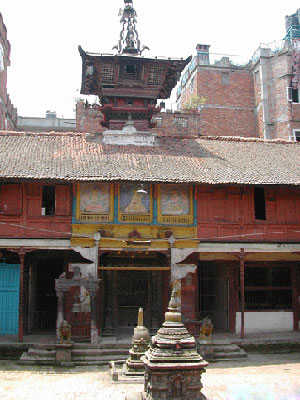

As you emerage into Nakabahi, you briefly rejoin the thoroughfare which leads to Darbar Square from Patan Dhoka. To your left is a well, and on your right, an
interesting three-sectioned pati. Beyond the pati is the long, two-story red-brick facade of the Lokakirti mahavihar (monastery). This building also doubles
as a school; a sign in English announces, “Shree Chandee Vidyashrama, High English School, Co-education”.
Climbing the six stone steps leading up to the portal of the monastery, you will step over a huge wooden beam shaped like the running of a gigantic sleigh.
The beam once was part of the chassis of the Machhendranath chariot, which is used to take the Buddhist/Hindu deity Karunama Machhendranath (or Bungdeo)
around the town just before the monsoon breaks in June/July. Beacuse the chassis is considered sacred, it cannot be used for firewood, one finds, therefore,
pieces of chariot chassis incorparated into temple struts and pillars throughout Patan.
On the ground floor of the Lokakirti Mahavihar is a quadrangle with classrooms on the sides. If you arrive during school hours, you will notice children only
too willing to be diverted from the rote learning that is the rule in Nepali schools. At the center of the courtyard is pointed chaitya of shikhara (“mountain
peak”) style. At the rear of the chowk (courtyard) is a shrine, its entrance marked by two small stone lions. A dark and narrow passage leads around the
shrine for the devotees to make their clockwise circumambulations. On the first floor windows, are some rudimentary samples of traditional devotional
paintings known as pouba, Patan’s own version of thangka art.
As you leave the mahavihar and look out on the busy square, you will notice that this section of the town is well-tended, with new brick pavements and a
rebuilt dabali, or raised platform. These are indications of the community’s newfound commitment to preserve the ageold culture and identity of this part of
Patan. Another indication is the revival of a traditional dance festival, known as the Astamatrika, which is performed on the square’s dabali. Introduced in
the 17th century by King Srinivas Malla, the Astamatrika dance depicts the characters of the twelve deities (including eight protector goddesses) who once
helped overcome obstacles put on the path of the city dwellers by fearsome spirits. While performing complex rituals, the dancers wear masks representing the
various deities.
The population of this neighborhood is made up of the Vajracharyas, who serve traditionally as Buddhist priests; Shakyas, noted for their skill in
manufacturing intricate ornaments; and Dongol farmers, whose ancestores also served as palace guards of the Malla kings. (The Malla dynasty fuled the Valley
towns from the early 13th century through the early 18th century. They were preceded by the Lichhavi and followed by the Shaj dynasty of present-day Nepal.)
Across the busy street from your vantage point on the steps of the monastery/school, you’ll see a tiny white-washed shrine attached to a modern building.
Enter the alleyway (picture above) to the left of the shrine and take the tunnel-like passage way. A sign overhead announces, “Nyakachuka, Yala”.
 As you emerage into Nakabahi, you briefly rejoin the thoroughfare which leads to Darbar Square from Patan Dhoka. To your left is a well, and on your right, an
interesting three-sectioned pati. Beyond the pati is the long, two-story red-brick facade of the Lokakirti mahavihar (monastery). This building also doubles
as a school; a sign in English announces, “Shree Chandee Vidyashrama, High English School, Co-education”.
As you emerage into Nakabahi, you briefly rejoin the thoroughfare which leads to Darbar Square from Patan Dhoka. To your left is a well, and on your right, an
interesting three-sectioned pati. Beyond the pati is the long, two-story red-brick facade of the Lokakirti mahavihar (monastery). This building also doubles
as a school; a sign in English announces, “Shree Chandee Vidyashrama, High English School, Co-education”.